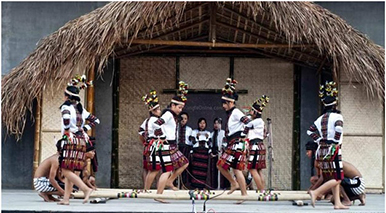Current Context:
The Manipur high court rescinded an order to exclude the Meitei community from the Scheduled Tribes list, causing a violent outburst.
About current context:
- The order affected the rights of 34 recognized tribes.
- Meiteis constitute 53% of the population live in the Imphal Valley, while Nagas and other tribes resides in a hill district.
- The Manipur high court has modified its order to remove the state government’s direction to include the Meitei community in the Scheduled Tribes list, following a violent verdict.

key points about the ongoing issue:
- Manipur, a northeastern Indian state, is grappling with a complex and deeply rooted conflict.
Ethnic Conflict:
- Many believe that the violence in Manipur has evolved into a civil war.
- The majority ethnic group, Meitei, and the minority group, Kuki, are the two largest groups involved in the situation.
- These groups are battling over land and influence.
Magnitude of Violence:
- Since May, at least 130 people have lost their lives, and 400 others have been wounded.
- Over 60,000 people have been displaced from their homes.
- The violence has led to the destruction of churches, temples, and entire villages.
Root Causes:
- The conflict initially erupted when Kukis protested the Meiteis’ demand for official tribal status.
- The Meiteis argued that this status would further strengthen the Kukis’ influence on government and society.
Other underlying factors include:
- A war on drugs by the Meitei-led government, which the Kukis perceive as a threat to their communities.
- Illegal migration from Myanmar, adding to land pressure.
- Unemployment, pushing youth toward various militias.
Conflict Dynamics:
- Meitei, Kuki, and Naga militias have historically clashed over homeland demands and religious differences.
- The current flare-up is primarily between the Meitei and the Kuki, rooted in ethnicity rather than religion.
- Rape and sexual assault have been used as instruments of violence, leading to a dangerous cycle of revenge attacks.
Kuki Tribe
Origins and Identity
- The Kuki people are an ethnic group primarily residing in the hills of Manipur. They also inhabit parts of Nagaland, Assam, Meghalaya, Tripura, and Mizoram.
- Their name is derived from the Tibeto-Burman language spoken by the tribe.
- The Kuki constitute one of several hill tribes within India and neighboring countries.
Cultural Aspects
- Warrior Tradition: The Kuki-Zomi tribe is renowned for its warrior skills. Historically, they defended their territories and maintained their independence.
- Christianity: Most of the Kuki people are Christians, which significantly influences their cultural practices and festivals.
- Land Ownership: Kukis face challenges in owning land in the forested hill districts, where only Scheduled Tribes (STs) have land rights.
Mataie Tribe
- The Mataie tribe is another significant indigenous group in Manipur.
- They inhabit the hilly regions alongside other tribes.
- Their lifestyle, customs, and language contribute to the cultural mosaic of Manipur.
Key Points
- Clan Structure: The Mataie tribe consists of numerous clans, each with its own distinct identity and traditions.
- Political Representation: The Mataie community has 20 MLAs in the Manipur state assembly, reflecting their political influence.
Other important tribes in Manipur:
Aimol:
- Language: Aimol language (classified under Kuki-Chin-Mizo language).
- Habitat: Parts of Chandel district, Senapati district, and around Loktak Lake in Bishnupur district.
Anal:
- One of the oldest tribes in the Southern hills of Tengnoupal district.
- Identity: Previously recognized as a Kuki tribe, but now they identify themselves as a Naga tribe.
Chiru:
- Among the earliest inhabitants of Manipur and Assam.
- Recognition: Designated as a Scheduled Tribe in 1956.
Other tribes in Manipur:
Chothe, Gangte, Inpui, Hmar, Kharam, Khoibu, Koirao, Kom, Lamkang, Liangmai, Mao, Maram, Maring, Mate, Monsang, Moyon, Paite, Poumai, Purum, Ralte, Rongmei (Kabui), Simte, Suhte, Tangkhul, Tarao, Thadou, Thangal, Vaiphei, Zeme, and Zou are other recognized tribes in Manipur.
Also Read:
Union Minister Ashwini Vaishnaw launches Annual Capacity Building Plan

